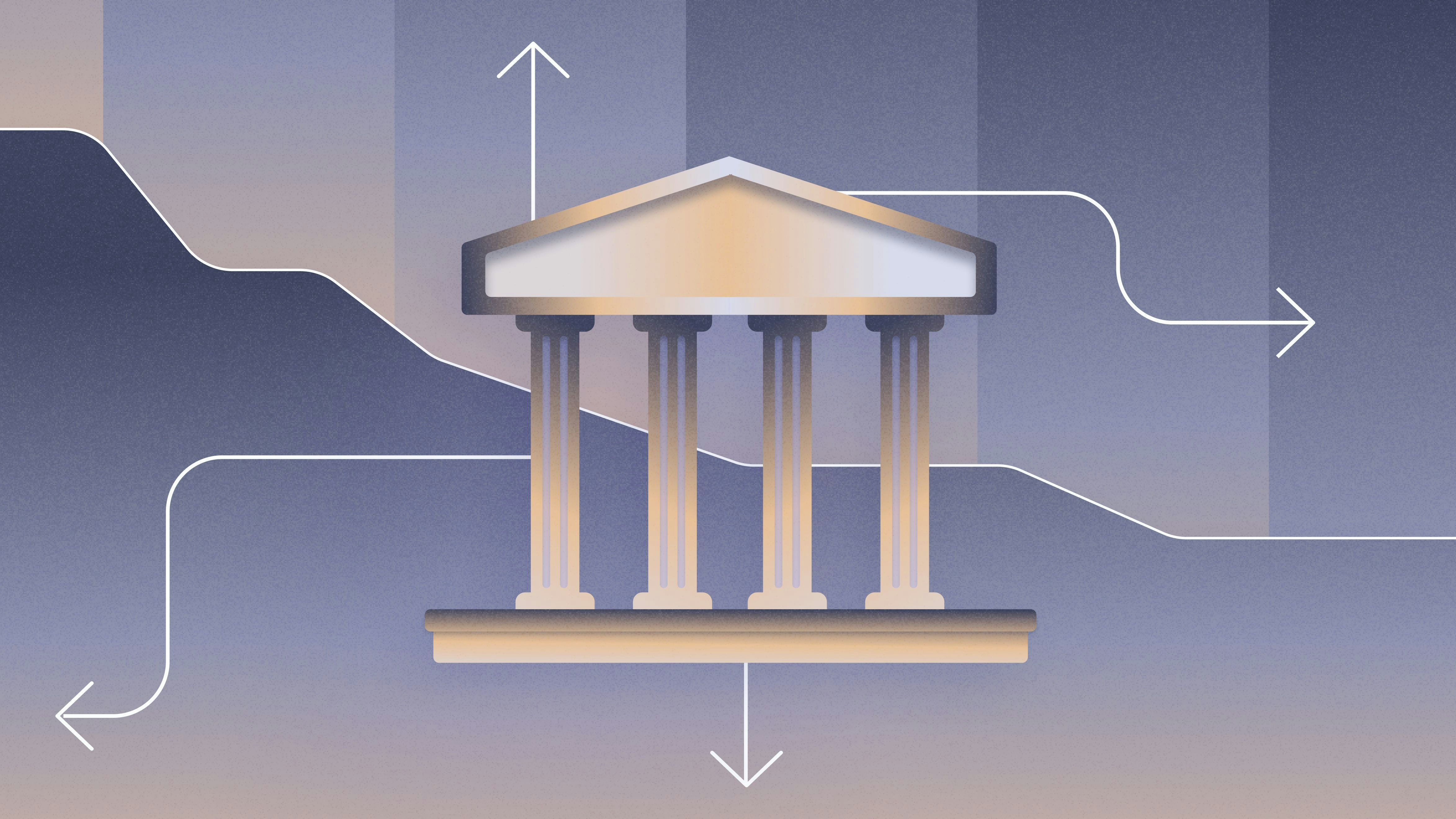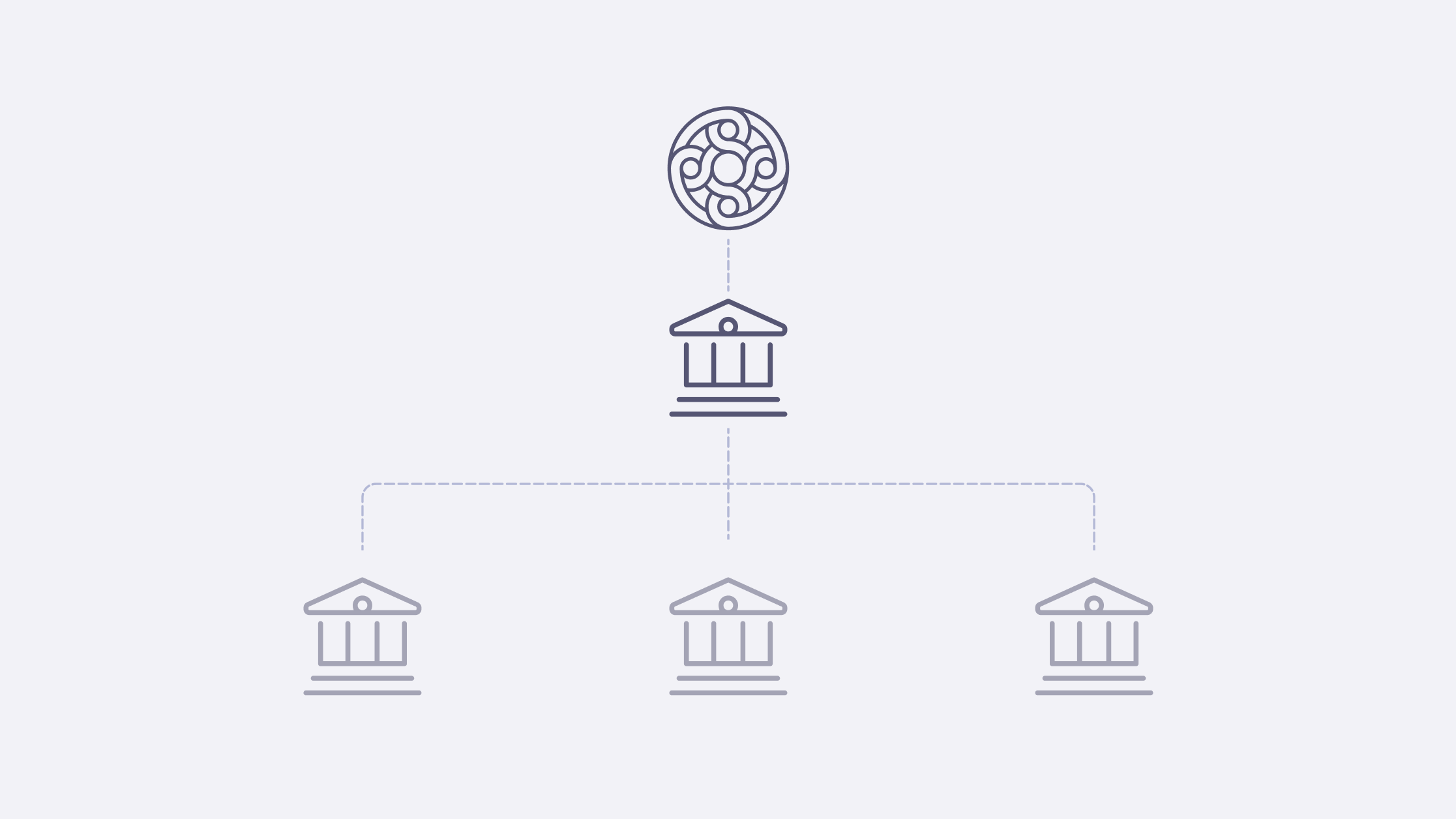What happens in a bank run, and what we can learn from past bank failures

When a bank is forced to close its doors, it leaves a lot of open questions behind. By understanding the circumstances and the decision-making behind the scenes of a bank failure, depositors can uncover important insights to learn how to protect their deposits.
This year saw the failure of three significant banks, beginning with Silicon Valley Bank, followed by Signature Bank and First Republic Bank shortly after. This wave of closures has resurfaced some familiar questions about the security of the banking system and begs the question, why do banks fail?
To answer that question, we must first dig into what it looks like for a bank to operate in good standing.
How a healthy bank operates
In order to diagnose the root causes of a bank failure, it’s necessary to first understand how a healthy bank operates. Fundamentally, the role of a bank is to take deposits and make loans and other investments. They provide a service, giving people and businesses a safe place to stow their cash, access it when needed, and move it around reliably.
One way that a bank makes money is from the difference between the interest income the bank receives on the loans, and interest expense paid to depositors, otherwise known as spread. This process of taking deposits and lending out a portion of them is called fractional reserve banking. The percentage of a bank’s deposits it must keep in reserves is established by the Federal Reserve. Perhaps more importantly, federal regulators will establish capital requirements a bank must set aside in connection with its operations, relative to the risk profile of its assets.
Certain key metrics are useful in evaluating the financial health of a bank. The components that determine this are interrelated and complex. However, at a high level, they reflect the quality of the assets a bank holds, whether a bank has enough cash on hand to shoulder losses, how adept its management team is in the arena the bank invests in, and more. The CAMELS rating system is a framework used by supervisors to monitor the health of banks. It evaluates a bank’s capital adequacy, asset quality, management, earnings, liquidity, and sensitivity to market risk. Banks are rated numerically on each of these factors on a scale from “strong” or “1,” to “critically deficient,” or “5.”
Factors involved in a bank’s failure
Banks can fail in a variety of ways. The most common way is insolvency. This occurs when a bank can no longer meet its obligations, and regulators are forced to intervene in a process called receivership. This involves the primary chartering authority revoking a bank’s charter, or license to engage in the business of banking, and appointing the FDIC to act as receiver for the failed bank. More often than not, the FDIC negotiates a sale to another bank, but in some extreme circumstances, there is no willing buyer. If there is no buyer, the FDIC will meet its statutory obligation to guarantee all depositors up to $250K and to liquidate the assets of the bank to repay the residual creditors. This approach is not all that different from a Chapter 7 bankruptcy, but is subject to a different statutory priority scheme that gives preference to the FDIC as receiver, insured depositors, and secured creditors.
But what are the circumstances that can cause a bank to collapse? Just as there are key factors in forecasting the health of a bank, a closer look at bank failures historically will show that, even before a collapse becomes inevitable, there are often early rumblings of the trouble to come. Alone, any of these factors can destabilize a bank’s footing — together, they can have seismic consequences. When we see a bank fail, it’s usually the result of interrelated factors, including:
Asset and liability mismanagement
When a bank loses too much on its loans or investments, or when the market value of its assets falls below its liabilities, it can spell trouble. This could be caused by a number of factors, including bad credit and underwriting practices, poor financial decision-making, and faulty forecasting, among other things.
“A lot stems from management,” explains John Popeo, a Partner at the financial advisory firm, The Gallatin Group — prior to which, he held various roles at the Federal Reserve Bank of Boston and the FDIC (Federal Deposit Insurance Corporation), where he was part of a task force that drafted regulations to implement the Dodd-Frank Act and led deals to sell and unwind more than 40 failing banks during the 2008 financial crisis.
- According to John, understanding the track record of a bank’s management team means asking questions like: Do they have experience in banking?
- Are they similarly experienced, and how can they leverage that baseline to ensure that the institution is undertaking risks that are appropriate to its size, scope, and operations?
- Are they engaging in prudent risk management and undertaking business lines and loan lending opportunities that make sense for that bank?
“One of the things I saw during the crisis [of 2008],” says John, “is smaller banks getting into things that were well beyond the area of their expertise.”
Additionally, a build-up in significant concentrations (such as uninsured deposits, long-term investments, or a significant volume of loans of one type or to one industry), low-quality loans, unhealthy loan-to-deposit ratios, and even ignoring direction from regulators are examples of poor management.
Reputational risk
Banking can be viewed as something of a confidence game. Remember, the basis of how all banks operate is by accepting deposits and loaning out a portion of them to create spread. Given this, some, if not most, of a bank’s assets can be tied up until those loans mature, making it impossible to pay out the majority of its depositors on demand, or in a short period of time. This is true even for a bank in a very strong position.
If the public loses confidence in a bank, it could cause a bank run, with depositors rushing to withdraw their cash for fear the bank will fail. A run on deposits can leave a bank with few options: obtaining a loan from the Federal Reserve or another institutional lender, raising capital, or selling off its assets —possibly at a loss — in order to meet withdrawals and leading to what is known as a liquidity crisis. Fear and anxiety can fuel the frenzy of withdrawals exponentially, making what was once a rumor about the bank’s demise become a self-fulfilling prophecy.
Liquidity and capital
Banks are regulated, steadfast institutions designed to weather a variety of economic climates — a single bad investment, liquidity event, or changes to an industry shouldn’t be enough to level a bank. That said, whether a bank is positioned to thrive will usually come down to various components.
A bank's capital is its cushion to cover possible losses a bank may incur. Regulators generally require banks to hold a specified amount of capital relative to the assets on their balance sheet. From a regulatory perspective, capital is measured using capital adequacy ratios. When a bank fails to meet these ratios, it may become subject to regulatory actions that may lead regulators to undertake measures to close the institution. A bank may accrue losses on its assets — possibly through borrower defaults or poor investments — or through fines and regulatory penalties, among other ways. Many of the bank failures that occurred during the Great Financial Crisis of 2008 were capital failures.
“At a high level, much of the emphasis [on a bank’s health] is on various components of the CAMELS rating system,” says John. In addition to this framework, a bank’s liquidity coverage ratio, or “LCR,” is one metric that can be used to assess how likely a bank is to survive a liquidity crisis. While the LCR generally applies to larger banking organizations, there are smaller liquidity ratios, such as a bank’s loan-to-deposit ratio, or “LDR,” that can also be used to evaluate a bank’s liquidity position.
A shift in the macroeconomic environment can expose or exacerbate any vulnerabilities a bank is already navigating. Take, for instance, rising interest rates. In theory, this should be viewed as a boon to banks as they can earn more on the loans they give out. However, rising rates can also be a curse in that they’re under pressure to keep depositors by more on customer deposits. If interest rates rise quickly, any loans or securities originated or purchased during the low-rate period would lose value quickly, possibly raising concerns about the bank’s financial condition. We saw this with the recent failures of Silicon Valley Bank and First Republic Bank.
Another example of external factors that exacerbate vulnerabilities is a global pandemic, such as the Covid-19 pandemic, which forced the workforce out of the office, causing the office and other commercial real estate markets to unexpectedly cool in an unprecedented way.
What we’ve learned about bank failures through history
Following the collapse of Silicon Valley Bank earlier this year, President Biden addressed Americans to reassure the country about the stability of the banking system, and the U.S. Treasury Secretary announced that all depositors of SVB would be guaranteed the full amount of their deposits. The scene echoes other episodes through times of economic uncertainty, such as the extraordinary measures taken to cover all bank deposits and money-market funds during the 2008 financial crisis. Or nearly a hundred years ago, when President Roosevelt introduced deposit insurance during the Great Depression in 1933.
So much can be gleaned by investigating the challenges faced by banks throughout U.S. history and how protections were put in place. Here, we’ll take a look at a few pivotal banking crises and how the system adapted to protect depositors:
Stock market crash and banking panics of 1929
Often considered one of the most catastrophic events in economic history, the stock market crash of 1929 incited mistrust in the financial system at large. One of the root causes of the crisis was rampant speculation by deposit-taking banks in the stock market. That is, many banks were using deposits to fund bets in stocks. When the speculative bubble burst, widespread banking panics ensued, causing massive bank runs and hundreds of bank failures. To reinstill trust in the system, Congress introduced deposit insurance to protect bank deposits and build back America’s trust in banks. It was also during this time that the FDIC was born.
Congress also required banks to fully separate commercial banking activities and investment banking activities. This was meant to protect the deposit-taking functions of banks from riskier investment-banking activities, essentially banning commercial banks from using depositor money to invest in the stock market and banning investment banks from accepting deposits.
Interest-rate risk and the Savings and Loan Crisis of the 1980s
High inflation episodes of the 1970s may strike some feeling of déjà vu when considering our current situation. Inflation during that time peaked at 14.8%, and the Federal Reserve responded with aggressive increases in interest rates, bringing the average interest rate of a 30-year fixed-rate mortgage to over 18% in 1981. During the same period, savings and loans — or thrifts, a type of bank that traditionally only offered savings accounts and residential mortgage loans — experienced a severe crisis. Since thrifts typically only offered simple savings accounts and long-term, fixed-rate mortgage loans, they could not compete as the Federal Reserve rapidly increased interest rates, and their spread shrank or even became negative.
At the same time, the fair market value of their fixed-rate mortgage loans decreased as interest rates in the market rapidly increased. In response, Congress passed legislation to allow thrifts to expand into other deposit and lending products (ever hear of adjustable-rate mortgages?) and to reduce regulatory oversight. As a result, many thrifts made far too many loans, reduced their underwriting standards, and began lending in areas where they were not familiar with the risk.
As the losses in the thrifts’ loan books piled up, their capital bases were depleted. In addition, some banks and other institutions were offering attractive rates causing depositors to move their money away from thrifts. These factors led to insolvencies, bank runs, and the ultimate failure of over 1,000 or nearly one-third of all thrift institutions in the U.S.
Loan concentrations and the 2008 financial crisis
The infamous financial crisis of 2007–2008 was precipitated by easy access to credit and loose lending standards that resulted in a housing bubble. It was also accompanied by new, complex financial products and increasing concentrations in real-estate loans as a result of looser lending standards. When the bubble burst, it left banks holding trillions of near-worthless investments and mortgage loans, setting off a wave of failures and enormous consequences for the wider economy.
Hundreds of banks failed, including monolith investment banks like Lehman Brothers and Bear Stearns, and retail banks like Indymac Federal Bank, FSB, and Washington Mutual. All were deeply involved in the precarious mortgage loans and lackadaisical lending practices of the time. If the banks’ poor decision-making wasn’t enough to seal their fates, a confidence crisis ensued, with investors selling off their shares and clients rushing to withdraw their money. Investors even began betting against the banks.
In response to the crisis of 2008, Congress passed legislation called The Dodd-Frank Wall Street Reform and Consumer Protection Act in 2010. This new law established additional measures and armed government agencies with additional supervisory tools to monitor financial institutions and to increase transparency and oversight in the banking industry. Basel III capital requirements were also introduced following the ‘08 crisis, the purpose being to mitigate bank risk internationally by requiring most banks — especially larger banking conglomerates — to increase the level and quality of their capital, maintain certain liquidity coverage ratios, and enhance reserves on hand.
A contagious loss of confidence in 2023
Fast forward to March of this year, the collapse of Silicon Valley Bank, a reputable institution that served the tech industry for decades, sent a new wave of ripples through the banking sector. The factors that led to the bank being taken over by the FDIC will sound familiar by now: investments that didn’t pan out in the current environment after the Federal Reserve raised interest rates so quickly, concentrations in uninsured deposits, poor risk management decisions — vulnerabilities turned disaster amidst a run on deposits.
Silicon Valley Bank invested heavily in U.S. government treasury bonds and highly-rated mortgage-backed securities, which are widely considered to be very safe. When interest rates were low, these investments were fine. But when interest rates rose rapidly, those fixed-rate bonds quickly lost value. Had SVB been able to simply wait until the bonds matured, there would have been no issue because the losses were unrealized losses. However, many depositors looked for alternative places to put their money that offered higher yields. As withdrawals accelerated, SVB was forced to sell those bonds, realizing a behemoth loss on their books. Rumors of the bank struggling combined with a large portion of the bank’s deposits being over FDIC-insured amounts magnified the problem.
“Uninsured deposits, in the event that a bank falters, are extremely susceptible to flight,” says John. Together these factors resulted in panic across the tech industry, causing the bank to implode.
This led to fears of a larger fallout across the commercial banking industry, causing a cascade of withdrawals across many other banks, especially Signature Bank and First Republic Bank. Not unlike SVB, Signature, and First Republic also had high concentrations of uninsured deposits and unrealized losses in their investment portfolios. Stock price can also be a proxy of the public’s confidence in an institution, John explains. “The stock price could precipitously fall and that, unto itself, could precipitate a deposit run.” Stock prices for SVB, Signature, and First Republic dropped drastically in the months and weeks leading up to the failure of those banks.
What we know going forward
Adjustments are likely to come to the banking world, in light of this year’s bank failures. John explains that regulators may “look to tweak some of the ratios applicable to large institution operations, with enhanced requirements in response to the recent failures.”
That said, the reality is that there is no single Achilles Heel we can point to when a bank falls. Instead, there are interrelated threats which include liquidity, concentrations, interest-rate risk, capital, reputation, and asset-liability management.
As we evaluate the events that led to bank failures across history, we can see these factors play out. Reputational risk led to bank runs during The Great Depression. Interest-rate risk and concentrations resulted in the failures during the Savings and Loan Crisis. Mismanagement and loan concentrations precipitated the 2007–2008 crisis. Most recently, we saw reputational risk combined with interest-rate risk and liquidity lead to bank runs at institutions with large concentrations of uninsured deposits.
In each scenario, reform and regulations are installed to keep a closer eye on the vulnerabilities that led to these failures so they can be avoided. Perhaps most importantly, they remind depositors of the importance of FDIC insurance — and extended coverage leveraged through sweep networks — as well as cash management strategies for protecting their funds.
Learn more about how Mercury works to ensure your cash is protected while you focus on scaling your business.
For the latest on financial services regulation, follow John Popeo on Twitter.



